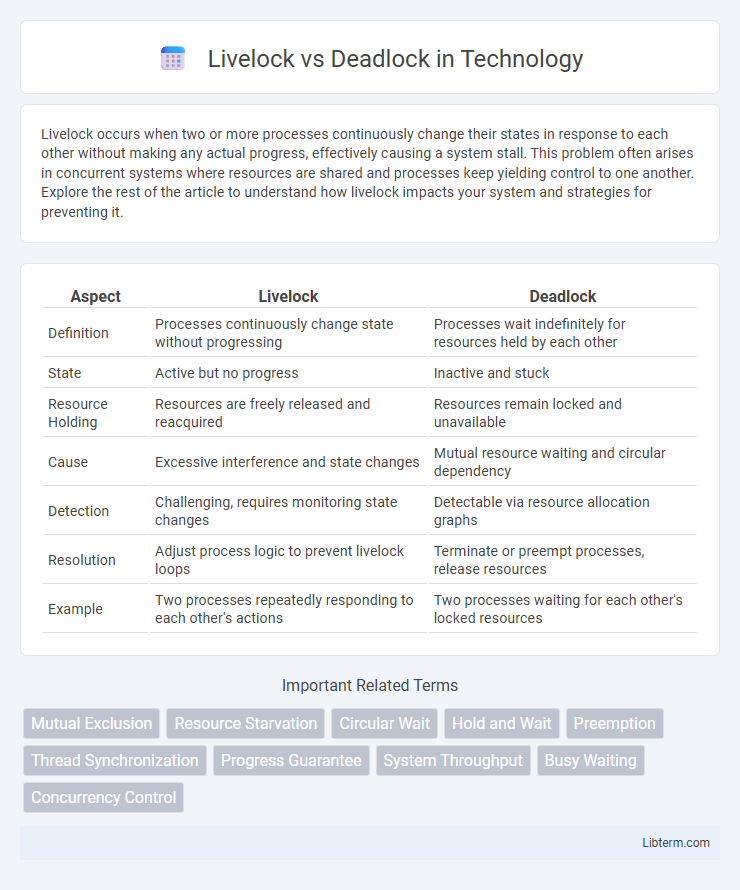Livelock occurs when two or more processes continuously change their states in response to each other without making any actual progress, effectively causing a system stall. This problem often arises in concurrent systems where resources are shared and processes keep yielding control to one another. Explore the rest of the article to understand how livelock impacts your system and strategies for preventing it.
Table of Comparison
| Aspect | Livelock | Deadlock |
|---|---|---|
| Definition | Processes continuously change state without progressing | Processes wait indefinitely for resources held by each other |
| State | Active but no progress | Inactive and stuck |
| Resource Holding | Resources are freely released and reacquired | Resources remain locked and unavailable |
| Cause | Excessive interference and state changes | Mutual resource waiting and circular dependency |
| Detection | Challenging, requires monitoring state changes | Detectable via resource allocation graphs |
| Resolution | Adjust process logic to prevent livelock loops | Terminate or preempt processes, release resources |
| Example | Two processes repeatedly responding to each other's actions | Two processes waiting for each other's locked resources |
Introduction to Livelock and Deadlock
Livelock and deadlock both represent states of resource contention in concurrent computing where processes are unable to proceed. Deadlock occurs when a set of processes are each waiting for resources held by others, creating a cycle of dependencies and halting execution. Livelock differs by involving processes that continuously change state in response to others without making progress, resulting in a system that is active but ineffective.
Understanding Process Synchronization Issues
Livelock and deadlock are critical process synchronization issues in concurrent computing, where livelock occurs when processes continuously change states without making progress, and deadlock happens when processes are stuck waiting indefinitely for resources held by each other. Both conditions degrade system performance by halting effective resource utilization and process execution. Detecting and resolving these synchronization problems involves careful resource allocation strategies, timeout mechanisms, and deadlock prevention algorithms.
What is Deadlock?
Deadlock occurs when two or more processes are each waiting for resources held by the other, causing all involved to halt indefinitely without progressing. This state typically arises in concurrent systems when mutual exclusion, hold and wait, no preemption, and circular wait conditions are all present. Deadlock detection and prevention algorithms are crucial in operating systems to maintain system reliability and resource availability.
What is Livelock?
Livelock occurs when two or more processes continuously change their state in response to each other without making progress, resulting in a system that is active but unable to complete tasks. Unlike deadlock, where processes are stuck waiting indefinitely, livelock involves processes actively running but stuck in a repetitive loop. This situation often arises in concurrent computing environments due to improper handling of resource allocation and process synchronization.
Key Differences Between Livelock and Deadlock
Livelock occurs when two or more processes continuously change their states in response to each other without making actual progress, whereas deadlock involves processes waiting indefinitely for resources held by each other, causing a complete halt. In deadlock, processes are blocked and unable to proceed, but in livelock, processes remain active yet fail to advance. Key differences include that deadlock results in a system freeze, while livelock leads to resource wastage and reduced system throughput despite ongoing process activity.
Causes of Deadlock in Concurrent Systems
Deadlock in concurrent systems occurs when multiple processes are each waiting for resources held by the others, creating a cycle of dependencies that prevents any process from proceeding. Key causes include mutual exclusion, hold and wait, no preemption, and circular wait conditions, which collectively lead to resource contention and indefinite blocking. Understanding these causes is essential for designing systems that implement resource allocation strategies to avoid deadlock scenarios.
Causes of Livelock in Concurrent Systems
Livelock in concurrent systems occurs when processes continuously change their states in response to each other without making progress, often caused by overly aggressive resource release and reacquisition strategies. This situation arises from improper handling of synchronization mechanisms, where processes remain active but fail to proceed due to constant communication or retries. Unlike deadlock, where processes wait indefinitely for resources, livelock involves active but unproductive state changes leading to system inefficiency.
Real-World Examples of Livelock and Deadlock
In real-world systems, deadlock often occurs in database management when transactions wait indefinitely for resources locked by each other, exemplified by two processes each holding a lock the other needs, causing a halt. Livelock appears in networking protocols, such as in TCP congestion control scenarios where packets continuously retry sending due to collisions but make no forward progress. Both situations result in resource inefficiency, but livelock involves active state changes without progress, whereas deadlock involves complete standstill.
Livelock and Deadlock Prevention Techniques
Livelock occurs when processes continuously change state in response to each other without making progress, whereas deadlock involves processes waiting indefinitely for resources held by each other. Deadlock prevention techniques include resource allocation strategies such as the Banker's Algorithm, imposing strict resource ordering, and utilizing wait-die or wound-wait schemes to avoid circular wait conditions. To prevent livelock, employing backoff algorithms, random delays, or priority adjustments allows processes to break free from continuous state changes and proceed toward completion.
Conclusion: Choosing the Right Concurrency Strategy
Livelock occurs when processes continuously change states without making progress, whereas deadlock involves processes waiting indefinitely for resources. Selecting the right concurrency strategy requires analyzing system requirements, prioritizing resource allocation, and implementing mechanisms like timeouts or priority inheritance to prevent both conditions. Effective concurrency control enhances system performance, reliability, and responsiveness in multitasking environments.
Livelock Infographic

 libterm.com
libterm.com